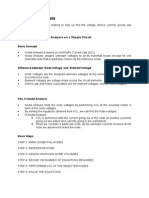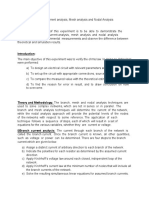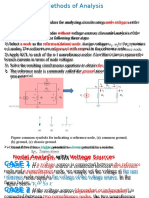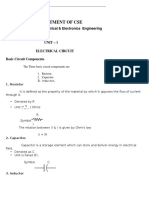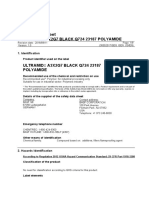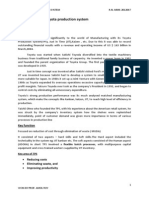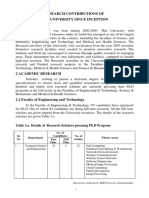School of Natural Resources Engineering & Management
Department Of Energy Engineering
Electrical Circuits Lab (ENE 213)
Experiment 05
5. Multi-Loop Circuits
5.1 Objectives
To use the node-voltage circuit analysis method to determine all the node voltages in a
circuit with respect to a reference node.
To use the mesh-current circuit analysis method to determine all the mesh currents in a
circuit.
Be able to decide whether the node-voltage method or the mesh-current method is the
preferred approach to solving a particular multi-loop circuit.
5.2 Introduction and theory
So far, you have analyzed relatively simple resistive circuits by applying Kirchhoff’s laws in
combination with Ohm's law. You can use this approach for all circuits, but as they become
structurally more complicated and involve more and more elements, this direct method soon
becomes inconvenient. In this lab we use two powerful techniques of circuit analysis that aid in the
analysis of complex circuit structures: The node-voltage method (nodal analysis) and the mesh-
current method (mesh analysis). These techniques give you two systematic methods of describing
circuits with minimum number of simultaneous equations.
The node-voltage method of circuit analysis consists of the following sequential steps:
- All nodes of a circuit are identified and one node is selected as the reference node.
- All nodes’ voltages are defined with respect to a reference node.
- All of the branch currents are expressed in terms of the nodes’ voltages using the passive
reference direction “the positive voltage drop across any branch is at the tail of the branch
current arrow".
I=V/R
- Kirchhoff’s current law (KCL) is written at each node using the positive reference direction
“branch currents out of a node are positive"
I i 0
- The resulting set of node-voltage equations are then written in matrix form.
- The node voltages are found by solving the set of linear equations.
1
�School of Natural Resources Engineering & Management
Department Of Energy Engineering
Electrical Circuits Lab (ENE 213)
The mesh-current method of circuit analysis requires the following sequential steps:
- All meshes are identified by a mesh current. The mesh current direction is determined
when the meshes are assigned. The choice of mesh current direction is arbitrary. A popular
choice is to take the mesh current "out of” the "+" terminals used for all the remaining
meshes of the circuit.
- All the branch voltage drops are expressed in terms of the mesh currents using the positive
reference direction: "the positive voltage drop across any branch is at the tail of the branch
current arrow ".
- Kirchhoff's voltage law (KVL) is written around each mesh following the mesh current
direction.
V i 0
- The resulting set of mesh current equations is then written in matrix form
- The mesh currents are found by solving the set of linear equations.
Superposition
Electrical circuits sometimes could be called linear circuits; mainly because of the linear
characteristics between current and voltage. This implies that the principle of superposition could be
applied. Super position principle states that the current through, or voltage across, an element in a
linear bilateral network is equal to the algebraic sum of the currents or voltages produced
independently by each source. In simple words, if a circuit is excited by two different independent
sources (current or voltage), and the desire is to find a current through or voltage across any element
in the circuit, then this desired current or voltage is found first with the existence of one source and
the other course is killed. The next cycle, is killing the first source and activating the second one and
finding the desired current or voltage again. The desired current or voltage finally is the sum of the
currents or voltages that resulted from the two previous calculations. In case of more than two
sources, the same scenario is repeated for as many sources are there.
2
�School of Natural Resources Engineering & Management
Department Of Energy Engineering
Electrical Circuits Lab (ENE 213)
5.3 Procedures
Part 1
1- Connect the circuit in Figure 5.1 on your bread board. Make sure you record the measured
values of the used resistors. Use the measured values in your calculations.
Figure 5.1: Circuit for part 1.
2- Verify the connection with your instructor, and then connect the voltage supplies. Notice
that you need to connect the two channels from the power supply.
3- Measure the voltages across, and currents through the resistors. Fill in Table 5.1 the resulted
measurements.
4- Simulate the circuit using LT spice and compare the simulation results with the experimental
results.
5- Apply the nodal analysis method to this circuit and use the measured Voltages and
currents to verify this method.
Table 5.1: Practical results for part 1
V1 V2 V3 V4 V5 V6
I1 I2 I3 I4 I5 I6
Part 2
1- Connect the circuit in Figure 5.2 on your bread board.
2- Repeat the steps from 2 to 4 in part 1. Fill your measurements in table 5.2.
3- Apply the mesh analysis method to this circuit and use the measured Voltages and
currents to verify this method.
3
�School of Natural Resources Engineering & Management
Department Of Energy Engineering
Electrical Circuits Lab (ENE 213)
Figure 5.2: Circuit or part 2.
Table 5.2: Practical results for part 2
V1 V2 V3 V4 V5 V6
I1 I2 I3 I4 I5 I6
Part 3 : Superposition
1- Connect the circuit in Figure 5.3 on your bread board. Make sure you record the measured
values of the used resistors. Use the measured values in your calculations.
Figure 5.3: Circuit for part 3.
2- Measure the voltages across, and currents through the resistors. Fill in Table 5.3 the resulted
measurements.
3- Disconnect the voltage source V1 by replacing it with a short circuit, and then measure the
voltages and currents as in table 5.3.
4- Disconnect the voltage source V2 by replacing it with a short circuit, and then measure the
voltages and currents as in table 5.4.
4
�School of Natural Resources Engineering & Management
Department Of Energy Engineering
Electrical Circuits Lab (ENE 213)
Table 5.3: Practical results for part 2
V1 V2 V3
I1 I2 I3
Table 5.3: The results while using V2 only.
V`1 V`2 V`3
I`1 I`2 I`3
Table 5.4: The results while using V1 only.
V``1 V``2 V``3
I``1 I``2 I``3
5- The summation of the results from step 3 and 4 should be equal to the results from step 2 as
the superposition theorem.
Table 5.4: The summation of step 3 and 4.
V`1 + V``1 V`2 + V``2 V`3 + V``3
I`1 + I``1 I`2 + I``2 I`3 + I``3


